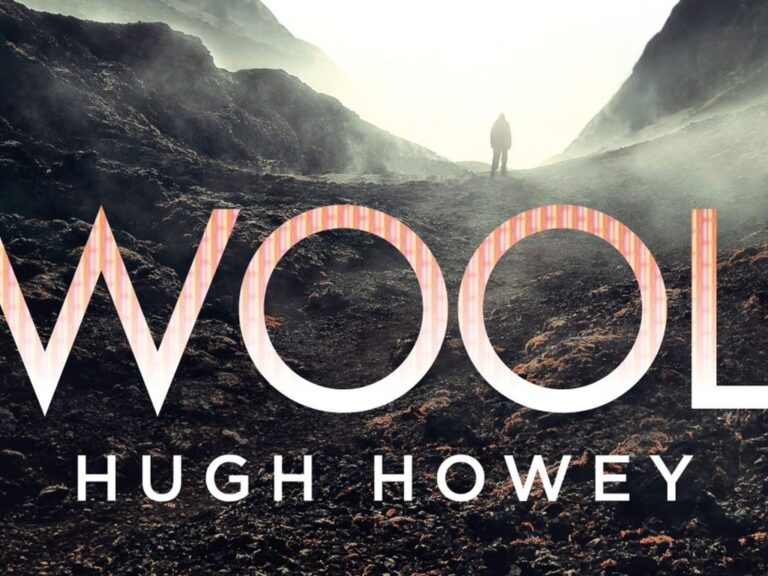Find out if Wool (2012), the first book in the Silo series by Hugh Howey worth reading.
This month the second season of the Apple TV+ series Silo is being released. So, I thought it would be a good time to review Howey’s first book in the series.
About: Wool (2012)
- Author: Hugh Howey
- Release Date: January 27, 2012
- Publisher(s): Simon & Schuster, HarperCollins, and Brilliance Audio.
- Description: “This is the story of mankind clawing for survival, of mankind on the edge. The world outside has grown unkind, the view of it limited, talk of it forbidden. But there are always those who hope, who dream. These are the dangerous people, the residents who infect others with their optimism. Their punishment is simple. They are allowed to go outside.”
The book is known as “Science Fiction’s Answer to Fifty Shades of Grey.” That’s because, like the Twilight series it started out as a short story. The first 60 pages of Howey’s post-apocalyptic novel were self-published in July 2011. Readers were demanding more by October, so he complied. His book has reached US bestseller lists, is more than 500 pages long, has book agreements on both sides of the Atlantic, and Ridley Scott acquired the film rights. The film never happened, but it was turned into a television series by Apple TV.
However, Howey is harmed by the Fifty Shades comparison. The futuristic existence this author has envisioned is occasionally very unsettling, and he is a talented writer. Humanity has lived on this planet since the beginning of time, constructing everything people need underground in a massive subterranean silo and bunker hundreds of stories deep. The air is lethal. Only a fuzzy image of “lifeless hills… a familiar rotting skyline… ancient glass and steel” projected onto a wall provides a glimpse of the outside world. The capital penalty in the silo is “cleaning”: the offender is taken outside to polish the lenses before being overpowered by toxic gasses. The filth of the atmosphere gradually covers the cameras that record the view.
Wool begins with a 60-page chapter that may be the final hours of Holston, the silo’s sheriff, who is still grieving the loss of his wife from “cleaning” years before. He locks himself in the holding cell of the silo for no apparent reason. Holston remarked, “‘Get the mayor,'” He sighed, the deep breath he had been suppressing for three years. “Sell her that I’d like to go outside.”
The surplus of knowledge that dystopian fiction gives the reader allows them to observe the characters’ struggles for the truth while also knowing what the world used to be like. Howey delivers this in plenty. Holston is struggling to come to terms with the possibility that the world is larger than the 150 levels of the silo and its strict rules.
According to the priests, the silo has always existed and was built by a kind god to shield them from the lethal atmosphere outside. Much of the silo longs for the outside world, even though the edicts restrict even the slightest reference to it. However, ancient children’s books depict a colorful planet. But not Jules, Howey’s strong, resourceful mechanic who succeeds Holston as the main character. She finds the outer world “an uninhabitable wasteland devoid of anything useful” and completely uninteresting. She will undoubtedly have to face reality, and her quest to understand the whys and wherefores of the silo’s existence quickly turns out to be risky.
Some aspects of Wool are excellent, such as the first two parts, which are eerie, captivating, and enigmatic. Unusual, well-developed characters include Holston, the former mayor Jahns, and Holston’s deputy, Marnes. Aside from Jules’s lovely grease-stained heroine, Howey’s heroes endure some very terrible—and captivating—tribulations. His dystopian aspects, such as the lottery residents of the silo must undergo to be permitted to procreate after a death; the reality of living in a world divided by a single, massive staircase; and the claustrophobia of underground life, have given him great pleasure.
Other parts don’t work as well. I believe it’s due in part to the novel’s development. It began as an excellent short tale. The tightness and skill with which he started unraveled a little as he wrote, and that story expanded as readers fell in love with the universe Howey had built. He introduces a phony persona, Lukas, who is Jules’s love interest. He writes well most of the time, although occasionally, he gets a little flowery. He even once indulges in some genuinely gloomy love poetry (“Wait for me. Hold on to me. My sweetheart, wait there while I whisper these kind words into your ear”).
Nevertheless, it’s simple to understand why Wool captivated readers so rapidly. Wool is a fantastic work of fiction; it is bold and gorgeous, current, yet has a sense of classic science fiction. Characters in the world-building are as realistic as they can be, and the world-building is clear and believable. This is one of those novels you just can’t put down; the story grabs your attention, and the prose captivates you. Walking the balance between plot development and backstory, the pacing is perfect. I was practically out of breath waiting to see what would happen because the author creates tension towards the end.
Wool (2012) is worth reading, and I’m looking forward to the next book in the series.
Have you read Wool (2012) yet? Let us know what you think in the comments section below, and feel free to share this review on any social media platform.
You can also follow us on Twitter, Facebook, and Bluesky. Have a wonderful day, and read our previous book reviews.


